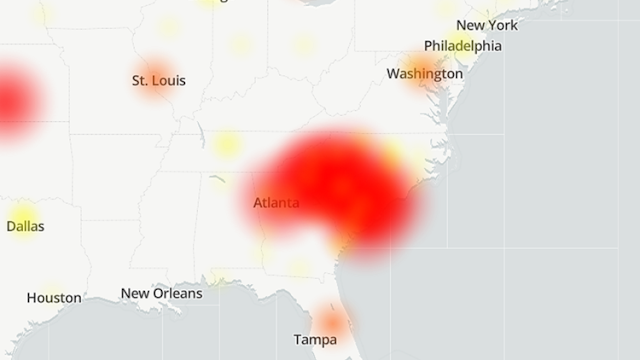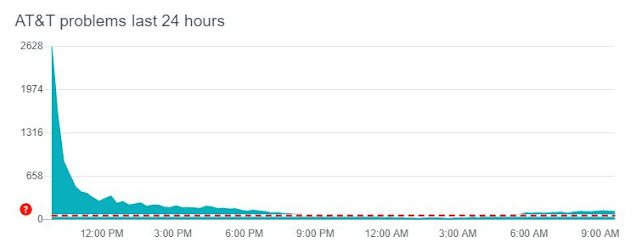Yesterday, according to DownDetector.com, reports of problems are coming from Myrtle Beach, Columbia, Charleston, Greenville, Spartanburg, and Charlotte, N.C. According to the site, reports started coming in shortly before 10 a.m. and exceeded 3,000 complaints.
South Carolina customers of AT&T experience phone outages throughout the state.
While the official AT&T and DirecTV Service Outages website shows "all clear," Downdetector.com, which reports internet and utility company outages, shows that service outages are recorded in the state of South Carolina and parts of North Carolina and Georgia.
Shortly after 4 p.m. a spokesman for AT&T released this statement on the matter:
“We worked quickly to restore service for customers in South Carolina who experienced interruptions caused by an equipment failure. We apologize for the inconvenience.” Here is an AT&T Map.
Is there an @ATT outage in SC?
— Darci Strickland (@DarciWLTX) September 28, 2020
Wireless networks are the backbone of modern communication, connecting millions of people every day for work, family, entertainment, and emergencies. But when outages occur, they can disrupt entire regions and impact millions of users. Recently, AT&T customers across the Southeastern United States experienced a major wireless outage that left many without service for hours. This event highlighted both the vulnerability of large-scale networks and the importance of resilience in the digital age. In this article, we explore what happened, why outages occur, the impact on customers, and what AT&T is doing to prevent future disruptions.
What Happened During the Outage?
AT&T customers in states such as Georgia, Florida, Alabama, South Carolina, and Tennessee reported widespread issues with mobile voice and data services. Many were unable to make or receive calls, send text messages, or access the internet. Reports began flooding into outage tracking platforms and social media within minutes. While the exact technical cause has not been fully disclosed, preliminary reports suggested a problem with AT&T’s core network routing equipment. Outages like this typically originate from software glitches, hardware failures, or maintenance errors, rather than physical damage to towers.
The Scale of the Disruption
The outage affected millions of customers across multiple states, including businesses, schools, and emergency services. Retail stores relying on wireless point-of-sale systems reported delays, while remote workers were forced offline. For individuals, the outage meant interrupted communication with family and friends. Although Wi-Fi connections helped some users stay online, those relying exclusively on cellular networks were left disconnected. Outages of this scale demonstrate how deeply dependent society has become on wireless services for daily functioning.
Impact on Emergency Services
One of the most concerning aspects of the outage was its effect on emergency communications. In certain areas, 911 centers reported difficulty receiving calls from AT&T customers. While backup systems helped minimize disruptions, such incidents highlight the risks when critical infrastructure fails. For first responders, reliable wireless communication is essential. Any disruption can delay emergency responses, potentially putting lives at risk.
How Customers Reacted
Social media platforms quickly filled with posts from frustrated AT&T users. Many reported dropped signals and complete service blackouts, while others experienced intermittent connectivity. Hashtags related to the outage trended across Twitter and Facebook, amplifying customer frustration. Some users shared workarounds, such as using Wi-Fi calling or switching temporarily to messaging apps like WhatsApp or Signal. These real-time reactions underscored how quickly news of outages spreads and how reliant people are on instant connectivity.
AT&T’s Response
AT&T acknowledged the outage through official statements, apologizing to customers and working to restore service as quickly as possible. Engineers were dispatched to identify and correct the problem. The company also coordinated with local authorities to ensure emergency systems were supported during the downtime. Within hours, most affected customers saw their service gradually restored. AT&T later confirmed that no cyberattack or security breach was involved, attributing the outage to a technical network error.
Why Wireless Outages Happen
Wireless outages can occur for a variety of reasons:
-
Network congestion: Overloaded systems can fail under heavy traffic.
-
Software updates or errors: Misconfigurations during routine updates can cause disruptions.
-
Hardware failures: Equipment malfunctions in core facilities or cell towers can lead to outages.
-
Fiber cuts: Construction accidents or natural disasters can damage critical fiber connections.
-
Cybersecurity threats: Though less common, cyberattacks can target critical network infrastructure.
In the case of AT&T’s outage, the cause appeared to be a technical misconfiguration rather than malicious activity.
Regional Dependence on AT&T
The Southeastern United States relies heavily on AT&T’s wireless network, with millions of subscribers in both urban and rural areas. AT&T’s dominance in this region means that outages have a larger impact compared to areas where carrier competition is more balanced. Small businesses, universities, and government agencies across the Southeast often use AT&T as their primary carrier, which magnified the disruption’s effects.
Business and Economic Impacts
For businesses, the outage created operational challenges. Restaurants using mobile payment systems reported slower transactions, delivery services experienced communication delays, and customer service centers struggled to stay connected with clients. While the outage lasted only hours, the ripple effect on productivity and customer satisfaction was significant. For some small businesses, even short service disruptions can result in lost revenue and frustrated customers.
Lessons From the Outage
Events like this highlight several key lessons:
-
Network resilience is critical: Carriers must invest in redundancy to minimize downtime.
-
Transparency builds trust: Customers expect clear communication during outages.
-
Backup systems are essential: Businesses and individuals benefit from alternatives like Wi-Fi calling and secondary carriers.
-
Preparedness reduces risks: Emergency services must have contingency plans when wireless networks fail.
By learning from outages, carriers like AT&T can strengthen their networks against future incidents.
What AT&T Is Doing to Prevent Future Disruptions
AT&T has committed to investing in infrastructure upgrades, particularly as it expands its 5G network. This includes:
-
Expanding fiber backhaul capacity to handle higher traffic volumes.
-
Deploying redundant systems to reduce the risk of single-point failures.
-
Enhancing monitoring tools that detect and isolate problems faster.
-
Collaborating with emergency agencies to ensure public safety systems remain functional.
While no network is immune to outages, these steps can reduce both their frequency and impact.
How Customers Can Prepare
Although consumers cannot prevent carrier outages, they can take steps to stay connected during disruptions:
-
Enable Wi-Fi calling to use broadband connections when wireless service fails.
-
Keep alternative apps ready such as WhatsApp, Signal, or Zoom for communication.
-
Consider dual-SIM phones that allow switching between two carriers.
-
Stay updated by following carrier announcements and outage trackers online.
These precautions help minimize inconvenience and maintain communication during service interruptions.
Conclusion
The major AT&T wireless outage in the Southeastern United States was a reminder of how critical mobile connectivity has become in daily life. From emergency services to businesses and individual users, millions felt the impact of even a temporary disruption. While AT&T restored service quickly and ruled out cyberattacks, the event highlighted the need for stronger resilience, better communication, and continued infrastructure investment. For consumers, being prepared with backup options can make all the difference when outages occur. As reliance on wireless networks grows, ensuring reliability is not just about convenience—it is about maintaining safety, productivity, and trust in the digital era.






